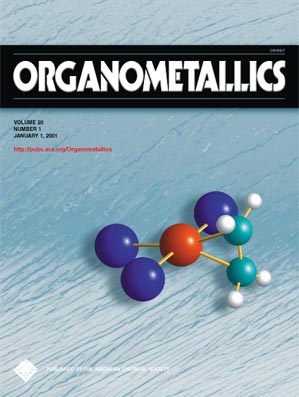







|
|
|
Journal
Publications |
|
Remarkable Differences in Catalyst
Activity and Selectivity for the Production of Methyl Propanoate versus
CO-Ethylene Co-Polymer by a Series of Palladium Complexes of Related
C4-Bridged Diphosphines.
J.G. Knight, S. Doherty, A. Harriman, E.G.
Robins, M. Betham, G.R. Eastham, R.P. Tooze, M.R.J. Elsegood, P.
Champkin, and W. Clegg Organometallics,
2000,
19, 4957. |
|
Abstract: The C4-bridged
diphosphines cis- and trans-1,2-bis(diphenylphosphinomethyl)cyclohexane
(cis, 1a; trans, 1b) and endo,endo-2,3-bis(diphenylphosphinomethyl)norbornane
and exo,endo-2,3-bis(diphenylphosphinomethyl)norbornane (endo,endo,
1c; exo,endo, 1d) and their corresponding palladium
complexes [(P-P)PdCl2] (2a-d), [(P-P)Pd(OAc)2]
(3a-d), and [(P-P)PdMeCl] (P-P = 1a, 4a; P-P
= 1c, 4c) have been prepared and characterized.
Single-crystal X-ray analysis of 2a reveals that 1a forms
a seven-membered chelate ring with the cis-disubstituted
cyclohexyl ring in the expected chair conformation. Variable-temperature
31P{1H} NMR studies of 2a have revealed a
dynamic process that interchanges stereoisomers via conformational
changes in the six-membered ring, often characteristic of cis-disubstituted
cyclohexane derivatives. The free energy of activation associated with
this exchange has been determined (DG‡
= 48 kJ mol-1, 2a). Variable-temperature 31P{1H}
and 31P NOESY NMR studies have shown that 4a exist as
an interconverting mixture of isomers which differ in the position of
the Pd-Me, trans either to an axial or to an equatorial
diphenylphosphinomethyl group. The free energy of activation associated
with this interchange (DG‡
= 44.2 kJ mol-1), as determined from a line shape analysis of
the 31P{1H} NMR spectra in the temperature range
213-308 K, is similar to that for 2a and consistent with a
process involving inversion of the cyclohexane ring. At 213 K, the
equilibrium population of these isomers is surprisingly disparate. Full
energy minimization calculations at the ZINDO(1) level gave an energy
difference between the two minimized structures of 4 kJ mol-1,
which corresponds to an equilibrium constant of 5 and is fully
consistent with that obtained using NMR spectroscopy. Single-crystal
X-ray analysis of 4a has revealed a square-planar geometry, such
that the axial diphenylphosphinomethyl group occupies the site trans
to the methyl and the equatorial diphenylphosphinomethyl group occupies
the position trans to the chloride. The single-crystal X-ray
structures of compounds 2d and 4c are also reported.
Methanol solutions of 3a-c and methane sulfonic acid are
selective for the copolymerization of ethylene with carbon monoxide,
generating low molecular weight polymers. Surprisingly, the activity of
catalyst systems based on cis-1,2-bis(diphenylphosphinomethyl)cyclohexane
(1a) is markedly higher than those based on its trans-isomer
1b. In contrast, catalyst systems formed from exo,endo-2,3-bis(diphenylphosphinomethyl)norbornane
(1d) are highly selective for the production of methyl propanoate
(>90%). |
| |
|
|
|



